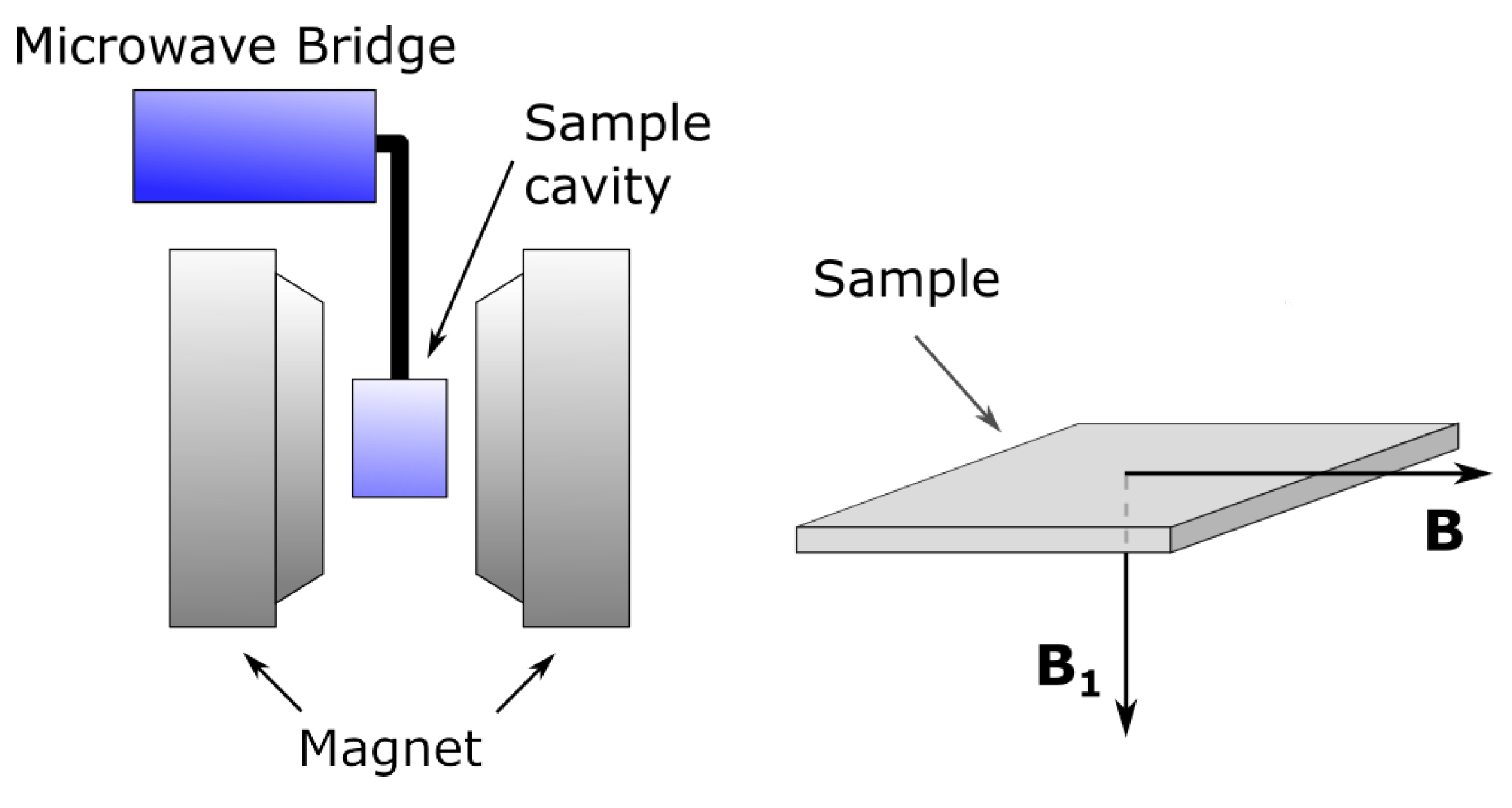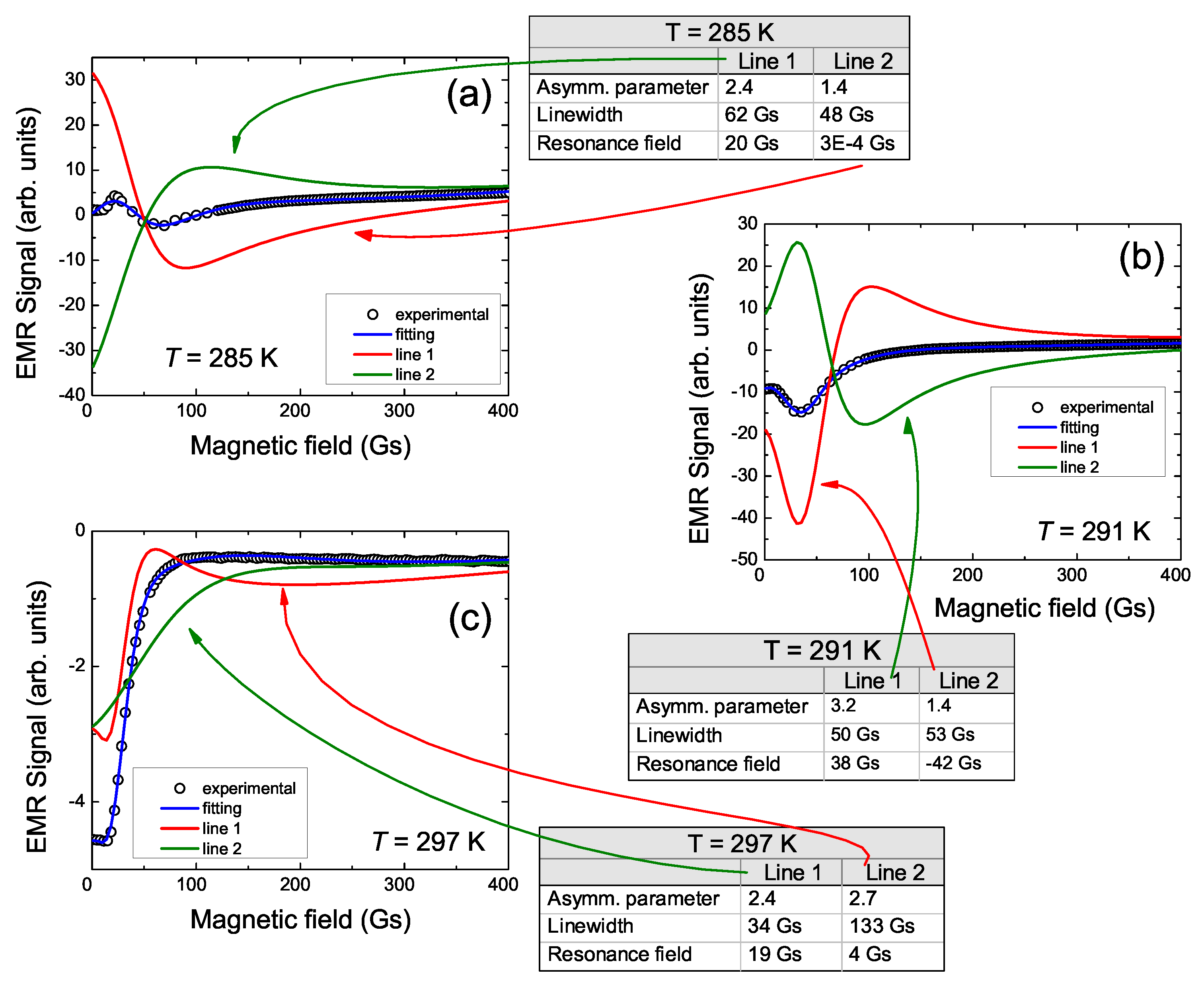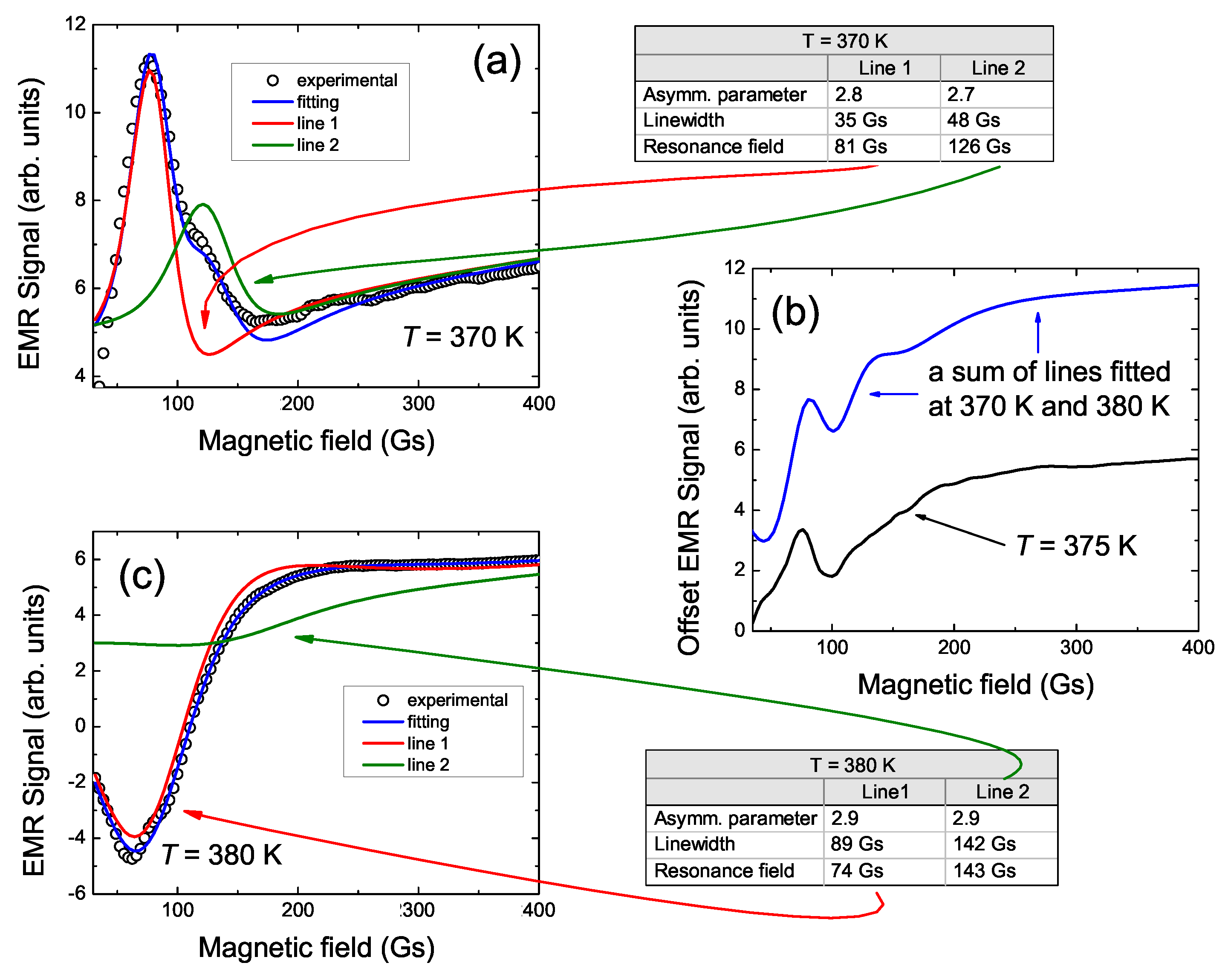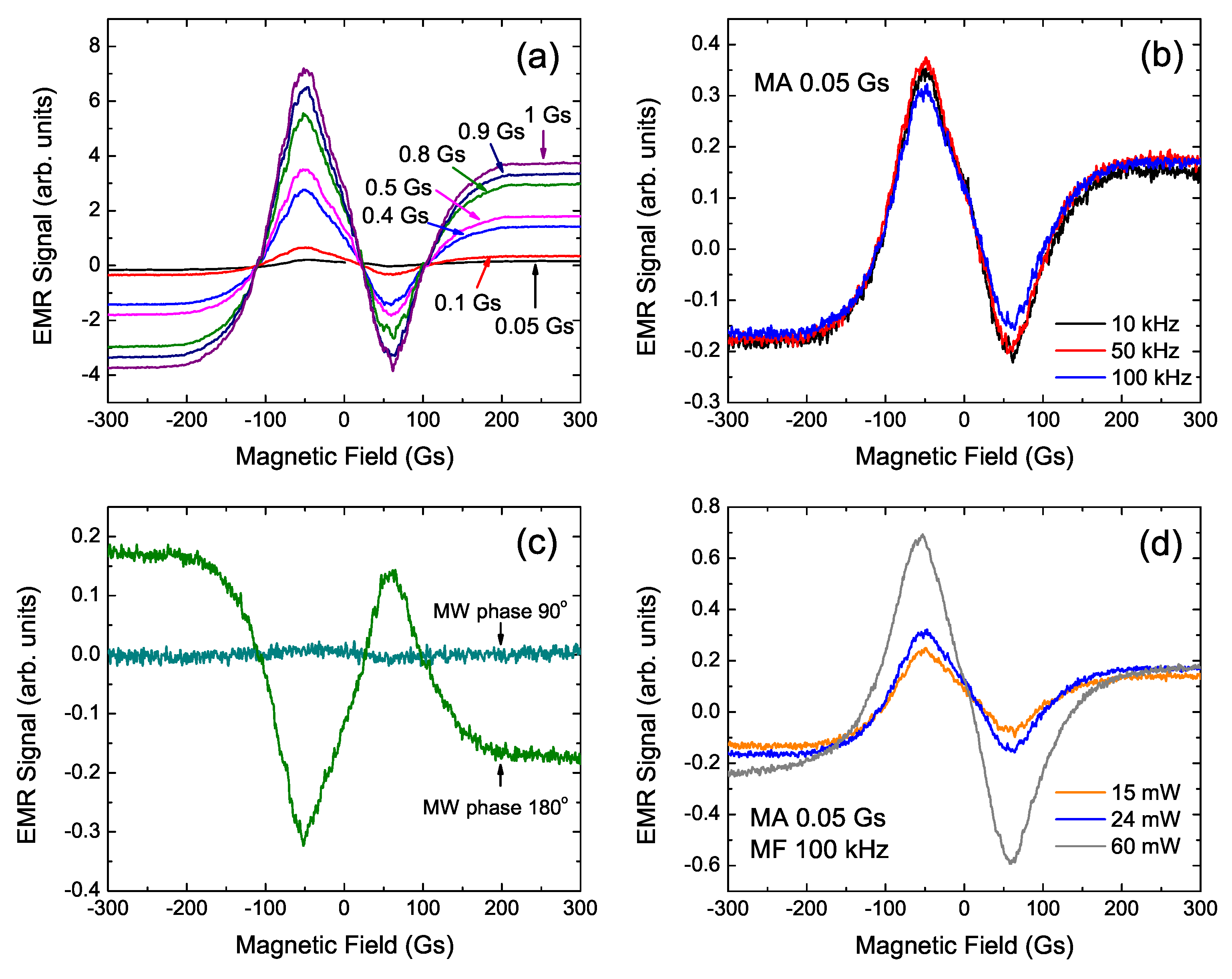The Low-Field Microwave Absorption in EMR Spectra for Ni50−xCoxMn35.5In14.5 Ribbons
Abstract
:1. Introduction
2. Materials and Method
3. Results
4. Conclusions
Author Contributions
Funding
Institutional Review Board Statement
Informed Consent Statement
Data Availability Statement
Acknowledgments
Conflicts of Interest
References
- Montiel, H.; Alvarez, G.; Gutiérrez, M.; Zamorano, R.; Valenzuela, R. Microwave absorption in Ni–Zn ferrites through the Curie transition. J. Alloys Compd. 2004, 369, 141–143. [Google Scholar] [CrossRef]
- Valenzuela, R.; Alvarez, G.; Montiel, H.; Gutiérrez, M.; Mata-Zamora, M.; Barrón, F.; Sánchez, A.; Betancourt, I.; Zamorano, R. Characterization of magnetic materials by low-field microwave absorption techniques. J. Magn. Magn. Mater. 2008, 320, 1961–1965. [Google Scholar] [CrossRef]
- García-Miquel, H.; Kurlyandskaya, G.V. Low field microwave absorption and magnetization process in CoFeNi electroplated wires. Chin. Phys. B 2008, 17, 1430–1435. [Google Scholar] [CrossRef]
- Alvarez, G.; Montiel, H.; Barron, J.; Gutierrez, M.; Zamorano, R. Yafet–Kittel-type magnetic ordering in Ni0.35Zn0.65Fe2O4 ferrite detected by magnetosensitive microwave absorption measurements. J. Magn. Magn. Mater. 2010, 322, 348–352. [Google Scholar] [CrossRef]
- Golosovsky, M.; Monod, P.; Muduli, P.K.; Budhani, R.C. Low-field microwave absorption in epitaxial La0.7Sr0.3MnO3 films that results from the angle-tuned ferromagnetic resonance in the multidomain state. Phys. Rev. B 2012, 85, 184418. [Google Scholar] [CrossRef]
- Valenzuela, R.; Ammar, S.; Nowak, S.; Vazquez, G. Low field microwave absorption in nanostructured ferrite ceramics consolidated by spark plasma sintering. J. Supercond. Nov. Magn. 2012, 25, 2389–2393. [Google Scholar] [CrossRef]
- Kim, J.; Kim, J.; Kim, K.H. Low-field microwave absorption behaviors on single layer magnetic film and exchange coupled multilayer magnetic film. Curr. Appl. Phys. 2014, 14, 548–551. [Google Scholar] [CrossRef]
- Montiel, H.; Alvarez, G.; Betancourt, I.; Zamorano, R.; Valenzuela, R. Correlations between low-field microwave absorption and magnetoimpedance in Co-based amorphous ribbons. Appl. Phys. Lett. 2005, 86, 072503. [Google Scholar] [CrossRef]
- Bhat, S.V.; Ganguly, P.; Ramakrishnan, T.V.; Rao, C.N.R. Absorption of electromagnetic radiation by superconducting YBa2Cu3O7: An oxygen-induced phenomenon. J. Phys. C 1987, 20, L559–L563. [Google Scholar] [CrossRef]
- Veinger, A.I.; Zabrodskii, A.G.; Tisnek, T.V. Use of magnetosensitive microwave absorption in a search for new superconducting phases. Supercond. Sci. Technol. 1995, 8, 368–373. [Google Scholar] [CrossRef]
- Padam, G.; Arora, N.; Ekbote, S. Anomalous hysteresis studies in Bi-2223/Bi-2212 superconductors by non-resonant microwave absorption (NRMA) with special reference to energy stabilized Josephson (ESJ) fluxons. Mater. Chem. Phys. 2010, 123, 752–755. [Google Scholar] [CrossRef]
- Dubiel, Ł.; Stefaniuk, I.; Wal, A.; Kuźma, M. Effect of annealing on the magnetic ordering and electron magnetic resonance of melt-spun Ni-Mn-In ribbons. J. Magn. Magn. Mater. 2020, 504, 166638. [Google Scholar] [CrossRef]
- Dubiel, Ł.; Wal, A.; Stefaniuk, I.; Żywczak, A.; Potera, P.; Maziarz, W. Cobalt Content Effect on the Magnetic Properties of Ni50−xCoxMn35.5In14.5 Annealed Ribbons. Materials 2021, 14, 5497. [Google Scholar] [CrossRef] [PubMed]
- Modak, R.; Srinivasan, A.; Srinivasu, V.V. Understanding low field microwave absorption in Ni-Mn based Heusler alloy films. Mater. Res. Bull. 2021, 143, 111453. [Google Scholar] [CrossRef]
- Maziarz, W. SEM and TEM studies of magnetic shape memory NiCoMnIn melt spun ribbons. In Solid State Phenomena; Trans Tech Publications Ltd.: Wollerau, Switzerland, 2012; Volume 186, pp. 251–254. [Google Scholar] [CrossRef]
- Feher, G.; Kip, A.F. Electron Spin Resonance Absorption in Metals. I. Experimental. Phys. Rev. 1955, 98, 337–348. [Google Scholar] [CrossRef]
- Ivanshin, V.A.; Deisenhofer, J.; Krug von Nidda, H.A.; Loidl, A.; Mukhin, A.A.; Balbashov, A.M.; Eremin, M.V. ESR study in lightly doped La1−xSrxMnO3. Phys. Rev. B 2000, 61, 6213–6219. [Google Scholar] [CrossRef]
- Dubiel, Ł.; Wal, A.; Stefaniuk, I.; Żywczak, A.; Maziarz, W. Electron magnetic resonance study of the Ni47Co3Mn35.5In14.5 ribbons. J. Magn. Magn. Mater. 2021, 530, 167930. [Google Scholar] [CrossRef]
- Dubiel, Ł.; Wal, A.; Stefaniuk, I. Anisotropy of g eff Factor for Ni50Mn35.5In14.5 Heusler Alloy. Acta Phys. Pol. A 2017, 132, 91–93. [Google Scholar] [CrossRef]
- Dubiel, Ł.; Żywczak, A.; Maziarz, W.; Stefaniuk, I.; Wal, A. Magnetic Phase Transition and Exchange Bias in Ni45Co5Mn35.5In14.5 Heusler Alloy. Appl. Magn. Reson. 2019, 50, 809–818. [Google Scholar] [CrossRef] [Green Version]
- Dubiel, Ł.; Stefaniuk, I.; Wal, A.; Żywczak, A.; Dziedzic, A.; Maziarz, W. Magnetic and structural phase transition in Ni50Mn35.5In14.5 ribbon. J. Magn. Magn. Mater. 2019, 485, 21–26. [Google Scholar] [CrossRef]
- Barnes, S. Theory of electron spin resonance of magnetic ions in metals. Adv. Phys. 1981, 30, 801–938. [Google Scholar] [CrossRef]
- Deisenhofer, J.; Krug von Nidda, H.A.; Loidl, A.; Sampathkumaran, E. ESR investigation of the spin dynamics in (Gd1−xYx)2PdSi3. Solid State Commun. 2003, 125, 327–331. [Google Scholar] [CrossRef]
- Quine, R.W.; Eaton, G.R. Setting the Microwave Phase in an EPR Spectrometer. J. Magn. Reson. 1996, 119, 268–270. [Google Scholar] [CrossRef]
- Mahule, T.; Das, J.; Srinivasu, V. Low-field microwave absorption in Zn1−x(Mn:Fe(Ni))xO (x = 0.02) system: Hysteresis, line shapes and powdering effects. Appl. Phys. A 2019, 125, 231. [Google Scholar] [CrossRef]
- Gavi, H.; Ngom, B.D.; Beye, A.; Strydom, A.M.; Srinivasu, V.; Chaker, M.; Manyala, N. Low-field microwave absorption in pulse laser deposited FeSi thin film. J. Magn. Magn. Mater. 2012, 324, 1172–1176. [Google Scholar] [CrossRef] [Green Version]
- Eaton, G.R.; Eaton, S.S.; Barr, D.P.; Weber, R.T. Quantitative Epr; Springer Science & Business Media: Berlin/Heidelberg, Germany, 2010. [Google Scholar]






| Label | Composition | Annealing |
|---|---|---|
| NC0MI-2 | Yes | |
| NC3MI-1 | No | |
| NC3MI-2 | Yes | |
| NC5MI-2 | Yes |
| Label | Composition | (K) | (K) |
|---|---|---|---|
| NC0MI-2 | 300 | 285 | |
| NC3MI-1 | 340 | 310 | |
| NC3MI-2 | 421 | 350 | |
| NC5MI-2 | 414 | 375 |
Publisher’s Note: MDPI stays neutral with regard to jurisdictional claims in published maps and institutional affiliations. |
© 2022 by the authors. Licensee MDPI, Basel, Switzerland. This article is an open access article distributed under the terms and conditions of the Creative Commons Attribution (CC BY) license (https://creativecommons.org/licenses/by/4.0/).
Share and Cite
Dubiel, Ł.; Stefaniuk, I.; Wal, A. The Low-Field Microwave Absorption in EMR Spectra for Ni50−xCoxMn35.5In14.5 Ribbons. Materials 2022, 15, 6016. https://doi.org/10.3390/ma15176016
Dubiel Ł, Stefaniuk I, Wal A. The Low-Field Microwave Absorption in EMR Spectra for Ni50−xCoxMn35.5In14.5 Ribbons. Materials. 2022; 15(17):6016. https://doi.org/10.3390/ma15176016
Chicago/Turabian StyleDubiel, Łukasz, Ireneusz Stefaniuk, and Andrzej Wal. 2022. "The Low-Field Microwave Absorption in EMR Spectra for Ni50−xCoxMn35.5In14.5 Ribbons" Materials 15, no. 17: 6016. https://doi.org/10.3390/ma15176016





